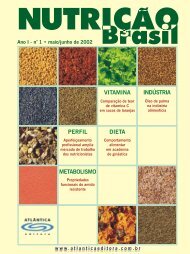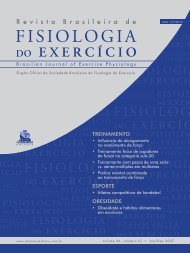Fisiologia do Exercicio_2005.pdf - Jean Peres
Fisiologia do Exercicio_2005.pdf - Jean Peres
Fisiologia do Exercicio_2005.pdf - Jean Peres
Create successful ePaper yourself
Turn your PDF publications into a flip-book with our unique Google optimized e-Paper software.
Revista Brasileira de <strong>Fisiologia</strong> <strong>do</strong> Exercício - Volume 4 Número 1 - janeiro/dezembro 2005<br />
Artigo original<br />
Predição <strong>do</strong> volume de exercícios com pesos para<br />
promoção da exaustão em três grupos musculares de<br />
atletas mediante variações de componentes sanguíneos<br />
Prediction of exercise volume with weight to promote exhaustion in three<br />
major muscular-groups of athletes through variation of blood markers<br />
Carlos Alexandre Fett*, Fábio Lera Orsatti**, Roberto Carlos Burini***<br />
*Faculdade de Educação Física da Universidade Federal de Mato Grosso – UFMT, **Professor de Educação Física, Centro de Metabolismo<br />
em Exercício e Nutrição (CeMeNutri) – Departamento de Saúde Pública da Faculdade de Medicina Botucatu/SP-UNESP,<br />
Mestran<strong>do</strong> em Ginecologia, Setor de Climatério e Menopausa – Faculdade de Medicina (UNESP), Botucatu (SP), ***Professor<br />
Titular, Centro de Metabolismo em Exercício e Nutrição – CeMENutri – Depto de Saúde Pública da Faculdade de Medicina da<br />
Unesp – Botucatu (SP)<br />
Resumo<br />
Com o objetivo de avaliar o impacto <strong>do</strong> teste de exaustão (TE),<br />
com exercícios resisti<strong>do</strong>s em três grupamentos musculares distintos,<br />
sobre a magnitude das alterações sangüíneas de atletas, foram estuda<strong>do</strong>s<br />
12 indivíduos (23 ± 4 anos) <strong>do</strong> sexo masculino (79 ± 10kg),<br />
atletas de musculação e voluntários ao estu<strong>do</strong>. Após 4 semanas de<br />
treinamento e dieta ajustada para 1,5g/kg/dia e 30 kcal/g prot., foi<br />
aplica<strong>do</strong> o TE que iniciava com 80% de 1 RM e redução de 20% até a<br />
fadiga (não execução da repetição). O TE foi realiza<strong>do</strong> para: 1) supino<br />
reto; 2) agachamento na máquina Hack ® ; 3) remada baixa no pulley,<br />
sem descanso entre os exercícios. Foram realizadas coletas de sangue,<br />
antes e após a realização <strong>do</strong>s três TE, para <strong>do</strong>sagens hemogasimétricas<br />
e bioquímicas. Após o TE, aumentaram as atividades das enzimas<br />
(U/L) creatino-quinase (CK), creatino-quinase isoenzima cardíaca<br />
(CK-MB), lactato desidrogenase (LDH), alanina aminotransferase<br />
(ALT), aspartato aminotransferase (AST) e os valores de glicose, Ca + ,<br />
Na + , PO , hematócrito, osmolalidade. Por outro la<strong>do</strong>, houve redução<br />
2<br />
signifi cativa <strong>do</strong> pH, HCO pCO e variação não signifi cativa <strong>do</strong><br />
3 e 2<br />
áci<strong>do</strong> úrico. Não houve correlação <strong>do</strong> teste de RM com o somatório<br />
das repetições no TE. Os indica<strong>do</strong>res isola<strong>do</strong>s mais sensíveis ao volume<br />
de exercícios foram a PCO e a AST que predizem até 50% e<br />
2<br />
40% das repetições, respectivamente. A associação da PCO , pressão<br />
2<br />
parcial de oxigênio (PO ), hematócrito (Ht), creatina quinase por-<br />
2<br />
ção cérebro-músculo (CK-MB) e bicarbonato (HCO ), têm o nível<br />
3<br />
preditivo máximo de aproximadamente 92%. O teste exaustivo <strong>do</strong>s<br />
3 grupamentos musculares leva a alterações sanguíneas indicativas de<br />
- estresse metabólico em que variações de pO , pCO , HCO , Ht, e<br />
2 2 3<br />
CKMB predizem 92% <strong>do</strong> esforço dispendi<strong>do</strong> no TE.<br />
Palavras-chave: marca<strong>do</strong>res bioquímicos, teste de exaustão,<br />
grupos musculares.<br />
17<br />
Abstract<br />
Th e responses of blood markers of fatigue -stress to exhaustive<br />
strength training were investigated in three diff erent groups of<br />
muscles of 12 males (23 + 4 yrs) volunteers, body builders. After 4<br />
weeks of training (5d/wk, 3x6-12 rep. 70-85% of RM, 30-60 seg<br />
rest among series) and dietary intake adjusted to 1.5g prot/kg/d<br />
and 30kcal/g prot they were submitted to the exhaustion test (ET)<br />
beginning with 80% of 1RM <strong>do</strong>wngrading 20% up to fatigue. Th e<br />
ET was conducted for muscular groups through 1) bench press, 2)<br />
squad and 3) seated row, without resting between exercises. Blood<br />
samples were drawn immediately before and after the ET and<br />
processed for hemogasimetric and biochemistry assays. Th e ET<br />
resulted in increased activities of enzymes (CK, CK-MB, LDH, AST<br />
and ALT), levels of osmolality (Osm), Na + , Ca ++ , Ht, glucose and<br />
pO 2 . Th e ET reduced the values of pH, HCO 3 and pCO 2 , without<br />
aff ecting the concentration of uric acid. Th ere was no relationship<br />
between the loading for 1RM (kg) and the number of repetitions<br />
to reach the ET. Blood pCO 2 and plasma AST showed (negative)<br />
signifi cant relationship with exercise volume for ET predicting<br />
50% and 40% of the achieved exercise repetitions, respectively. By<br />
associating both with pO 2 , CK-MB and HCO 3 the predictive value<br />
increased to 92%. Th us the responses of blood markers predict up<br />
to 92% of the volume of exhaustive strength exercise in the three<br />
major groups of user muscles during ET in athletes.<br />
Key-words: biochemistry markers, exhaustion test, musculargroups.<br />
Recebi<strong>do</strong> em 12 de abril de 2005, aceito em 15 de março de 2005.<br />
Endereço para correspondência: Roberto Carlos Burini, Rua Distrito de Rubião Júnior, s/n-UNESP/FM/BOTUCATU, 18618-970<br />
Botucatu SP, Tel: (014) 3811-6128, E-mail: burini@fmb.unesp.br





